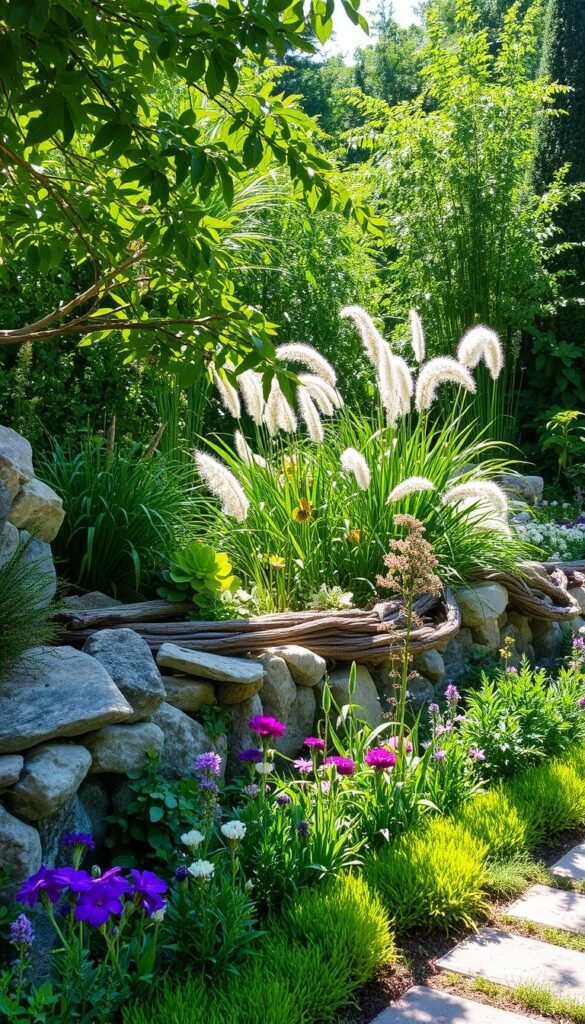Ever wondered how to give your yard a clean, organized look? Well-defined borders do more than separate grass from plants—they add character and structure to your landscape. With the right approach, you can turn functional edges into eye-catching features that reflect your personal style.
Simple solutions like repurposed materials or natural stones create visual interest while keeping mulch in place. You don’t need expensive tools or professional help—many projects take just a weekend to complete. From sleek metal strips to charming wooden logs, options adapt to any theme, whether modern or rustic.
Effective borders also solve practical problems. They stop grass from invading flower areas and make mowing easier. Plus, crisp lines give your property a polished feel without breaking the bank. Ready to explore how small changes can elevate your outdoor design? Let’s dive into clever techniques that blend function with flair.
Getting Started with Garden Edging
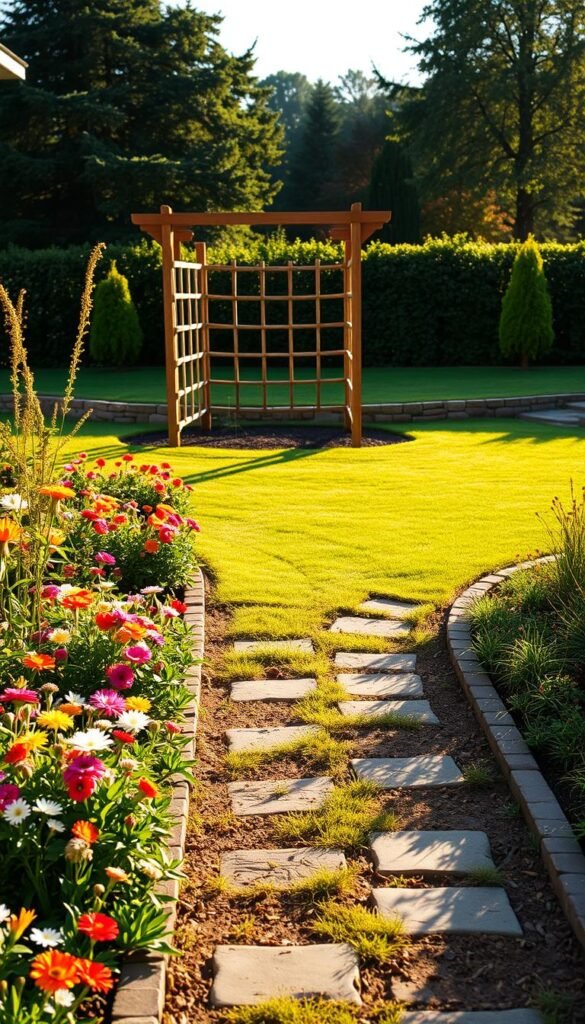
Creating crisp borders begins with smart planning. Start by walking around your yard to observe how plants, paths, and open areas interact. Look for spots where grass creeps into flower zones or where mulch spills onto walkways—these are prime candidates for borders.
Understanding Your Outdoor Space
Soil type and drainage matter more than you might think. Sandy soil? Flexible plastic strips could shift over time. Clay-heavy ground? Sturdy stone or metal holds better. If you’re working with square-foot gardening layouts, precise measurements ensure edges align perfectly with planting grids.
Choosing the Right Materials
Pick options that match your climate and style. Rustic wood blends with cottage gardens, while sleek aluminum suits modern yards. Consider these factors:
- Durability: Will it crack in winter frosts?
- Maintenance: Can you reseal wood annually?
- Budget: Recycled bricks cost less than custom-cut stone
Mix materials for visual variety—try combining curved pavers near patios with low-profile steel around vegetable plots. This approach adds personality while keeping maintenance manageable.
Understanding Different Edging Materials
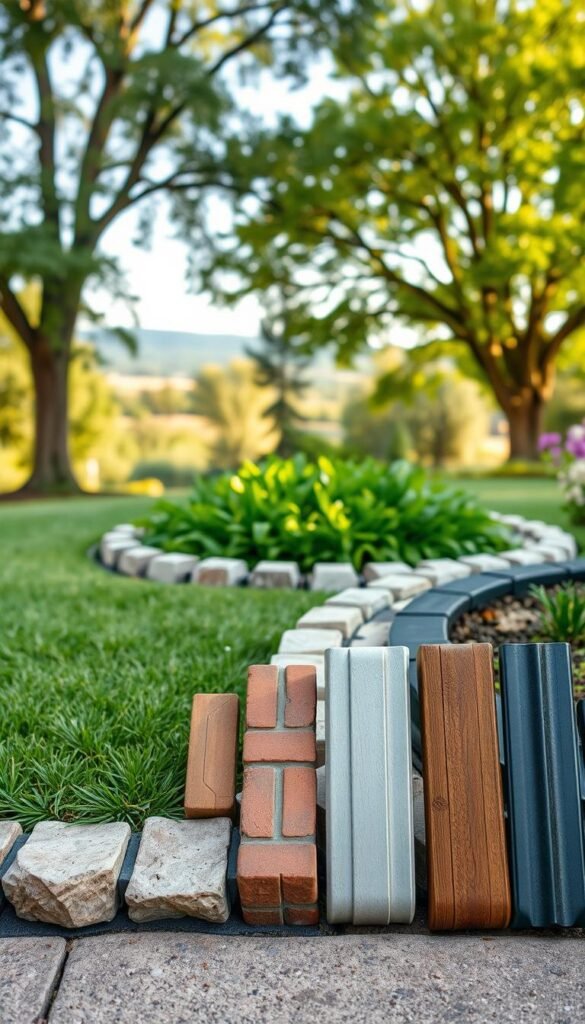
Every edging material brings its own strengths and challenges. Whether you prioritize affordability, eco-friendliness, or visual appeal, there’s a solution tailored to your needs. Let’s explore popular choices and their practical trade-offs.
Pros and Cons of Each Option
Plastic borders cost less upfront and last 5-8 years. They’re lightweight but require trench digging for installation. While practical, they lack the charm of natural materials.
Recycled glass bottles create whimsical patterns and reduce waste. However, they need careful placement to avoid sharp edges. Pair them with building raised beds for a cohesive recycled look.
Eucalyptus wood offers a relaxed vibe and simple setup. At $7 per foot, it’s budget-friendly but may warp in humid climates. Cedar shingles install quickly with a mallet but stay vulnerable to lawn equipment damage.
Consider these factors when choosing:
- Weather resistance: Metal handles freeze-thaw cycles better than wood
- Maintenance: Stone requires occasional weed-trimming, while rubber needs no upkeep
- Style impact: Brick adds classic structure, whereas bamboo brings tropical flair
Your local climate and design goals will steer you toward the best option. Balance durability with aesthetics to create borders that work as hard as they look.
Unique Garden Edging Ideas to Define and Frame Your Beds
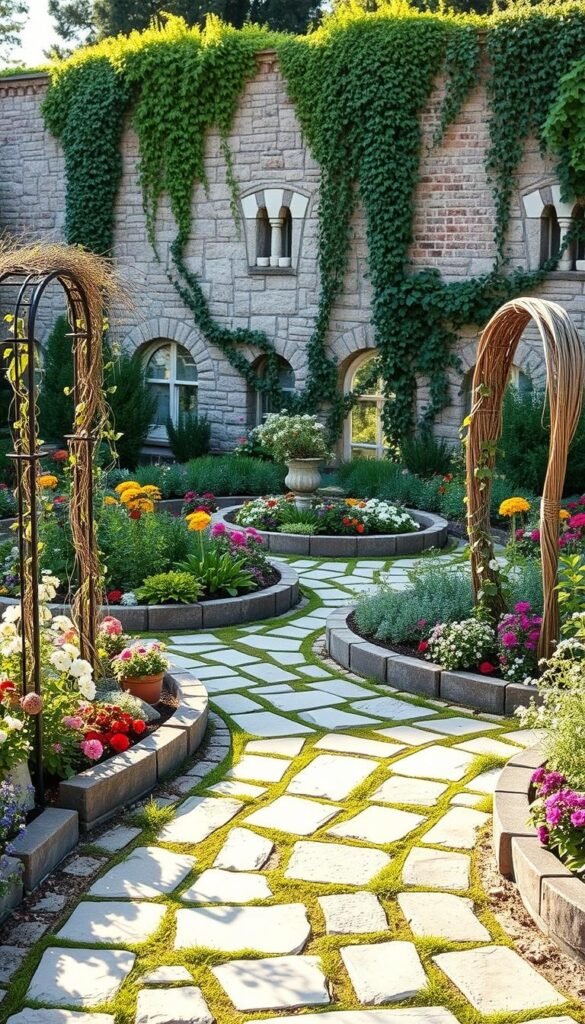
Who says borders need store-bought materials? Turn wine bottles upside down along pathways for jewel-toned accents that catch sunlight. Bury them neck-deep in staggered rows—their curved shapes create playful waves between planting zones.
Old terracotta pots become instant charm when stacked like towers. Alternate sizes and angles for a whimsical 3D effect around rose bushes. For woodland areas, arrange moss-covered logs end-to-end. Their natural curves mimic organic patterns while keeping mulch contained.
Mix materials strategically to solve specific issues. Combine steel strips with river rocks where lawn meets vegetable plots—metal stops grass invasion, while stones add texture. This dual approach tackles functionality while boosting curb appeal.
Salvaged tin cans painted in bold hues make cheerful markers for herb garden beds. Space them evenly or cluster in geometric patterns. Best part? These projects cost almost nothing if you repurpose items from garage sales or recycling bins.
Unexpected edges spark conversations and showcase your creativity. Try weaving willow branches between stakes for a living fence that softens hardscapes. As seasons change, these personalized touches evolve alongside your landscape’s story.
Budget-Friendly Plastic and Rubber Edging Options
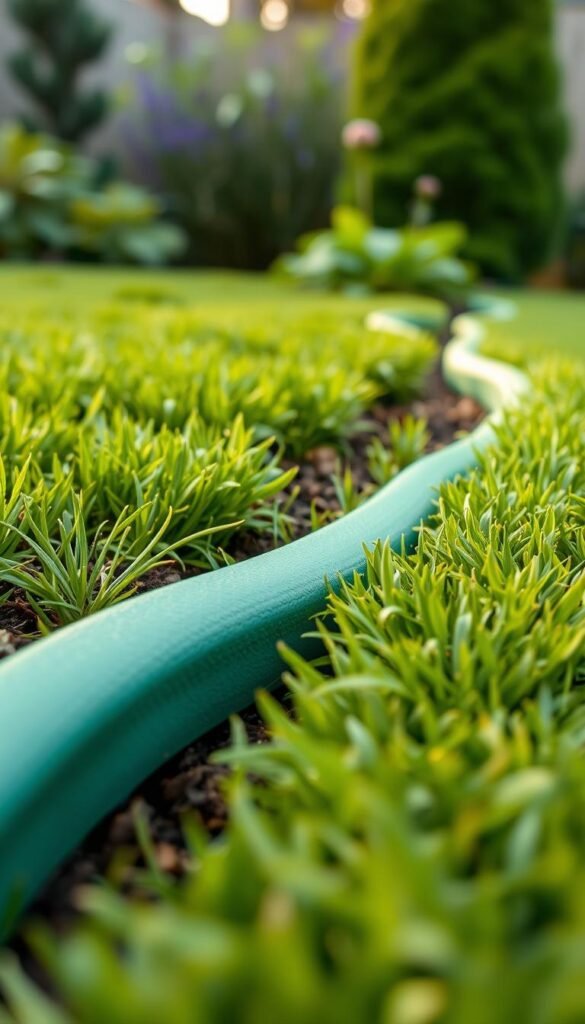
Looking for an affordable way to keep your landscape tidy? Plastic and rubber edging delivers crisp lines without draining your wallet. These materials withstand years of use while resisting rot, pests, and weather damage—perfect for DIYers wanting quick, polished results.
Ease of Installation
Plastic rolls let you create smooth curves with basic tools. Simply dig a shallow trench, position the strip, and backfill. Prefer less digging? Try pound-in styles with built-in spikes that anchor into soil. Recycled rubber pieces snap together and secure with metal pegs—no special skills needed.
Long-Term Durability
Modern plastic holds its shape through temperature swings, though frost might lift sections in colder zones. Rubber won’t crack or fade, surviving mower bumps and foot traffic. Both options need minimal upkeep compared to wood or stone. Just rinse them occasionally to maintain their fresh look.
Why choose synthetic edging? It’s lighter than stone, cheaper than metal, and faster to install than brick. You’ll spend less time maintaining borders and more enjoying your yard’s clean lines. For tight budgets or rental properties, these materials offer smart, lasting solutions.
Innovative Recycled and Upcycled Edging Ideas
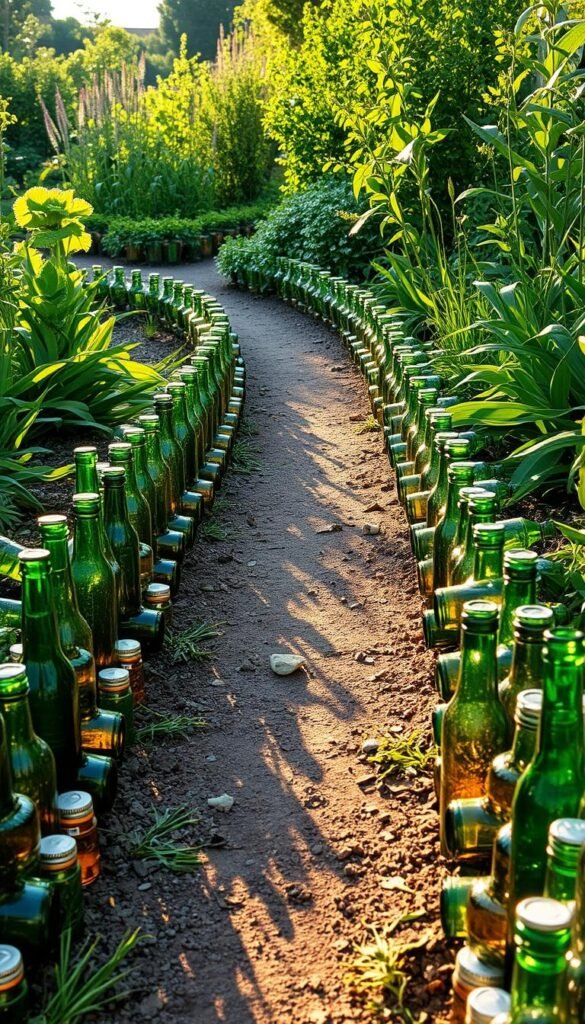
Turn trash into treasure by crafting garden edges from discarded materials. Empty glass bottles become shimmering borders when buried neck-down along beds. Arrange them in zig-zag patterns or color-coordinated rows—their translucent bodies catch sunlight like stained glass.
Repurposing Glass Bottles and Tin Cans
For stability, dig trenches 6 inches deep and space bottles 2-3 inches apart. Fill gaps with soil and tamp firmly. Green or brown varieties blend with nature, while blue ones add coastal flair. Want bolder looks? Try alternating hues like amber and emerald.
Tin cans offer playful DIY edging opportunities. Remove labels, punch drainage holes, and paint them in sunset orange or mint green. Cluster three cans together for textured height variations. Pair them with upcycling household items like old silverware for quirky accents.
Mix materials for layered effects. Line a path with wine bottles, then add tin-can markers every 4 feet. This combo stops mulch migration while showcasing your eco-conscious touch. Both options withstand rain and won’t rot like wood.
Best part? You’re saving landfill space. A 10-foot border uses 30-40 bottles or 50 cans—imagine the impact if every gardener tried this! These projects cost pennies but create conversations that outshine store-bought strips.
Charming Natural Wood and Log Edging
Want borders that add warmth to your landscape? Natural wood brings earthy textures that soften hard lines while blending seamlessly with plants. Whether you prefer the casual feel of eucalyptus or the rugged charm of cedar, these materials create borders that age beautifully over time.
Rustic Appeal and Natural Texture
Cedar shingles install in minutes with a rubber mallet—perfect for curved paths or circular beds. Eucalyptus offers similar simplicity at $7 per foot, though it works best in drier climates. For a bold organic look, use repurposed logs from fallen trees. Stand them upright like sentries or lay them horizontally for low-profile borders.
Wood’s natural aging process enhances its character. Untreated cedar develops silvery-gray patinas, while oak logs grow mossy surfaces that attract beneficial insects. Apply linseed oil annually to slow decay in wetter regions. Rot-resistant species like black locust last 5-7 years untreated—ideal for low-maintenance spaces.
These materials shine in cottage gardens and woodland settings. Pair split logs with ferns for a forest-floor vibe, or frame vegetable plots with cedar strips. Locally sourced wood reduces costs and environmental impact, making your edging both sustainable and budget-friendly.
Creative Brick and Stone Edging Techniques
Transform your landscape with materials that stand the test of time. Brick and stone edging brings classic structure to pathways and flower zones while resisting weather extremes. Their natural textures blend effortlessly with both formal layouts and casual cottage designs.
Layered Brick Edge Designs
Stack bricks in staggered rows for depth and visual weight. Horizontal placement creates subtle lines, while vertical arrangements make bold statements. Use a 1-inch sand base to prevent shifting, and angle each layer slightly outward for rainwater runoff.
For curved beds, space bricks with gaps filled by mortar or creeping thyme. This technique softens hard edges and adds organic charm. Pair red clay bricks with lavender beds or whitewashed ones with succulents to enhance your outdoor aesthetic.
Stone Pillar Installation Tips
Flat fieldstones work best for pillar-style borders. Dig trenches 8 inches deep, adding gravel for drainage. Dry-stack stones tightly, alternating sizes to lock pieces in place. Cap each pillar with a broad flat rock to create seating spots or display potted herbs.
Though labor-intensive, these structures last decades. Choose local stone varieties to cut costs—limestone in the Midwest or slate in New England. Their neutral tones adapt as your plantings evolve, ensuring your borders always feel intentional.
Modern Metal and Concrete Edging Designs
For crisp, contemporary borders that stand the test of time, metal and concrete deliver unmatched precision. These materials create sharp lines that frame plants like living artwork while handling harsh weather and heavy use.
Sleek, Industrial Look
Aluminum strips offer a slim profile for minimalist designs. They’re lightweight yet sturdy, bending smoothly around curves without visible seams. Corten steel develops a warm rust patina over time, adding earthy tones to modern spaces. Its weathered look pairs perfectly with ornamental grasses or succulents.
Corrugated metal brings texture with its wavy pattern. Use it vertically for height or horizontally for subtle movement. Precast concrete blocks come in geometric shapes—think hexagons or chevrons—that form bold patterns when repeated.
Installation Tips for a Polished Finish
For metal edging, dig trenches 4 inches deep. Backfill with gravel to prevent shifting in freeze-thaw cycles. Overlap sections by 2 inches when joining pieces. Concrete requires forms and rebar for poured borders—hire pros for complex curves.
| Material | Durability | Cost per Foot | Maintenance |
|---|---|---|---|
| Aluminum | 15-20 years | $3.50 | Wipe annually |
| Corten Steel | Lifetime | $8.00 | None |
| Precast Concrete | 30+ years | $6.50 | Seal every 5 years |
Pair these materials with gravel paths or polished stone decks. Their clean lines make flower colors pop while keeping mulch neatly contained. Though pricier upfront, their decades-long lifespan makes them smart investments.
Eco-Friendly and Sustainable Garden Borders
Looking to blend sustainability with style? Natural materials like bamboo and willow create borders that nurture your yard while reducing environmental impact. These renewable options add texture and charm without compromising on durability.
Working With Flexible Natural Fibers
Bamboo stakes bring tropical flair to modern spaces. Pound them vertically into soil at 6-inch intervals, then weave twine horizontally for stability. Their golden hue complements leafy greens and flowering shrubs, especially in cottagecore-inspired designs.
Willow branches offer rustic appeal through traditional wattle techniques. Soak cuttings overnight to increase flexibility, then interlace them between wooden posts. This living fence softens hardscapes and supports climbing plants like sweet peas.
Both materials age gracefully—bamboo develops silvery patinas, while willow sprouts new shoots in damp soil. They decompose naturally over time, enriching your soil instead of clogging landfills. Plus, their organic shapes encourage beneficial insects to thrive.
For low-maintenance garden borders, these options outlast plastic while blending seamlessly with nature. They prove eco-conscious choices can be practical and visually striking.

